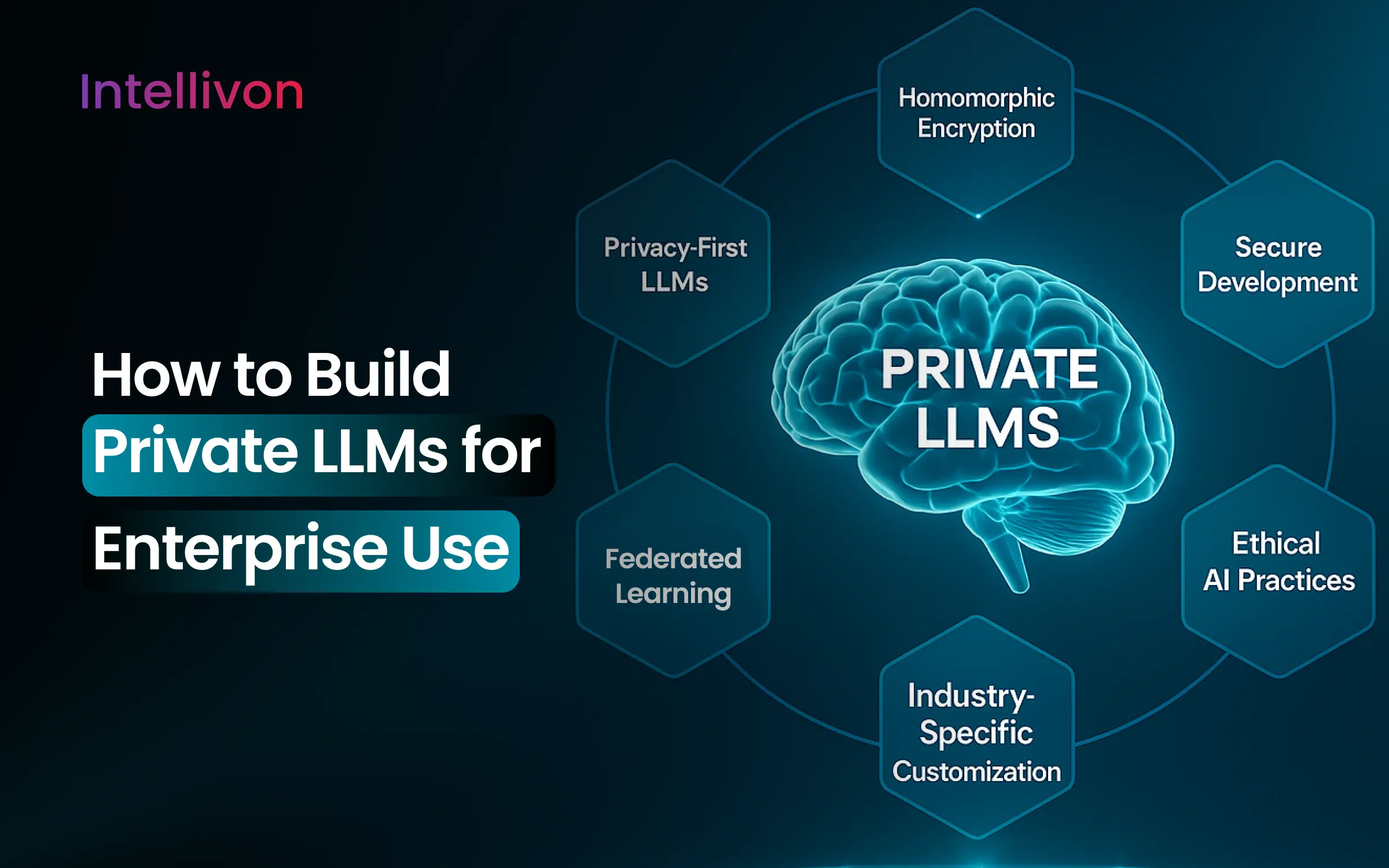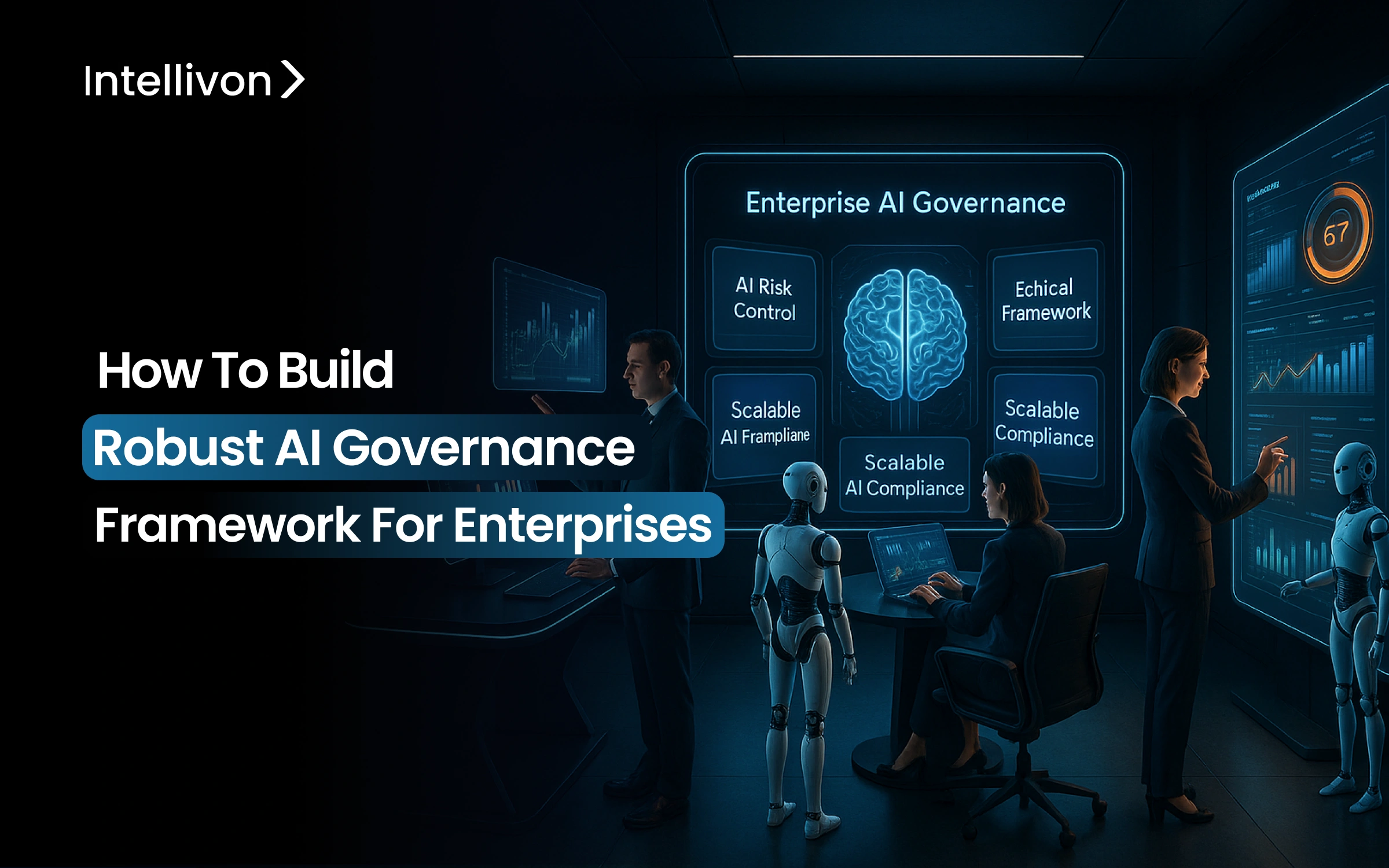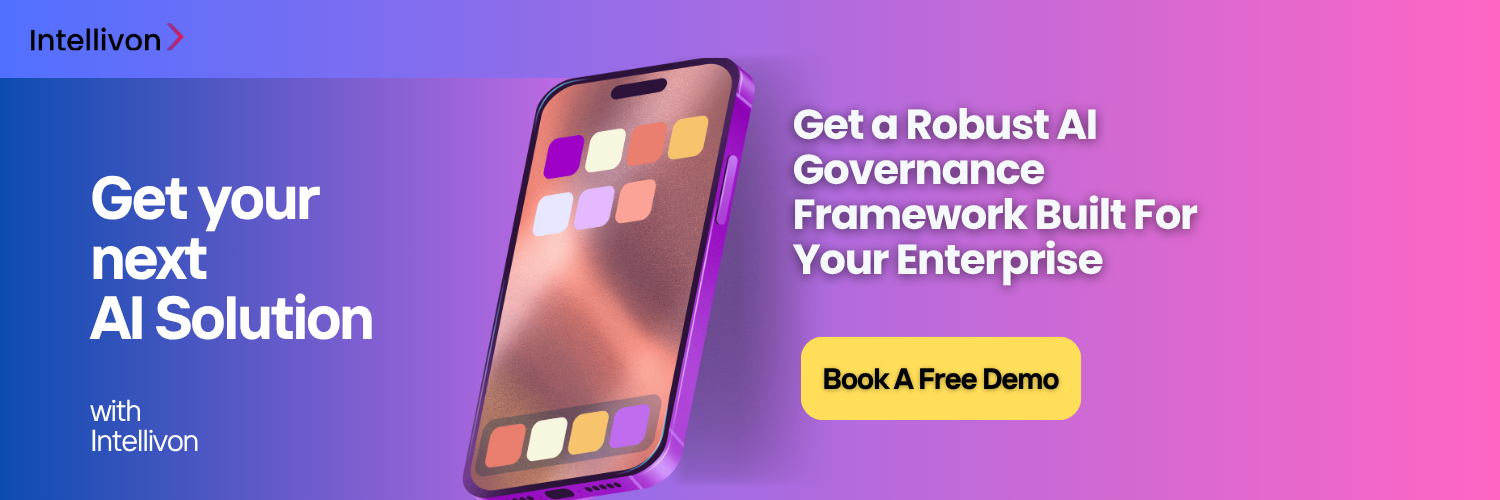Enterprises today face growing pressure to ensure their AI systems are ethical, secure, and compliant with regulations. As AI becomes more integrated into every facet of enterprise operations, the risks associated with its unchecked deployment also rise. 89% of enterprises worry about AI security risks, but only 24% think their organizations have strong governance in place.
Companies that fail to govern AI effectively can face serious consequences, including hefty fines, legal liabilities, and erosion of public confidence. That’s why building an AI governance framework that is scalable, transparent, and adaptable to future regulations is essential for any enterprise striving to stay competitive and compliant in the age of AI.
At Intellivon, we specialize in building tailored AI governance frameworks that evolve with your AI maturity and regulatory requirements. Whether you’re just beginning to scale or managing complex AI initiatives, we provide solutions that help you navigate challenges while maintaining control. We’ve seen firsthand how the lack of proper governance can lead to delays, costly fines, or even a loss of customer trust. This guide will walk you through how we approach AI governance for our enterprise clients and how we can help build a scalable, compliant framework for your enterprise AI.
What is AI Governance and Why Are Enterprises Adopting It?
AI governance is a set of rules and systems that guide how companies use AI. It includes frameworks, policies, and oversight to make sure AI is used in a safe and responsible way. This means setting ethical standards, following laws, and managing risks.
AI governance covers every stage of AI, from design to launch and beyond. It ensures that AI tools are trained, tested, used, and improved in line with company values and legal requirements. In short, robust AI governance helps organizations use AI to its full potential for necessary business operations while avoiding harm.
Key Market Insights of AI Governance
The global AI governance market is expected to grow rapidly, from $309 million in 2025 to about $4.83 billion by 2034, at a CAGR of 35.7%, according to Precedence Research. Large companies, mainly in finance, healthcare, and tech, make up about 70% of the market because they face more complex regulations.
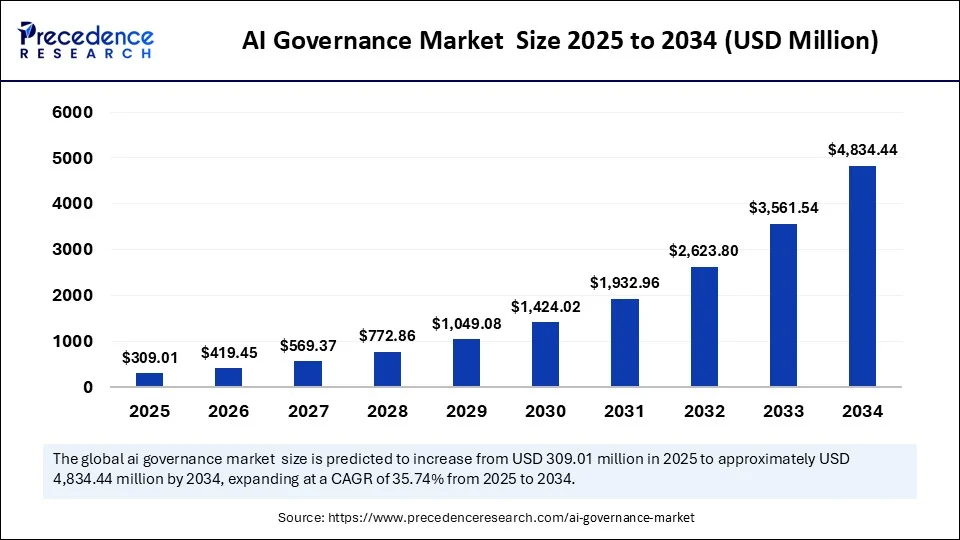
- North America leads with 31% of the market in 2024, thanks to strong regulations and digital infrastructure.
- Big companies in finance, healthcare, and defense hold about 70% of the market.
- Market growth is driven by more global AI use and new regulations to manage risks like bias, privacy, and security.
Why Enterprises Need AI Governance
AI is changing how business operations work. More enterprises now use AI to solve big problems and create value. However, this rapid growth also brings serious challenges. That’s why strong AI governance is so important.
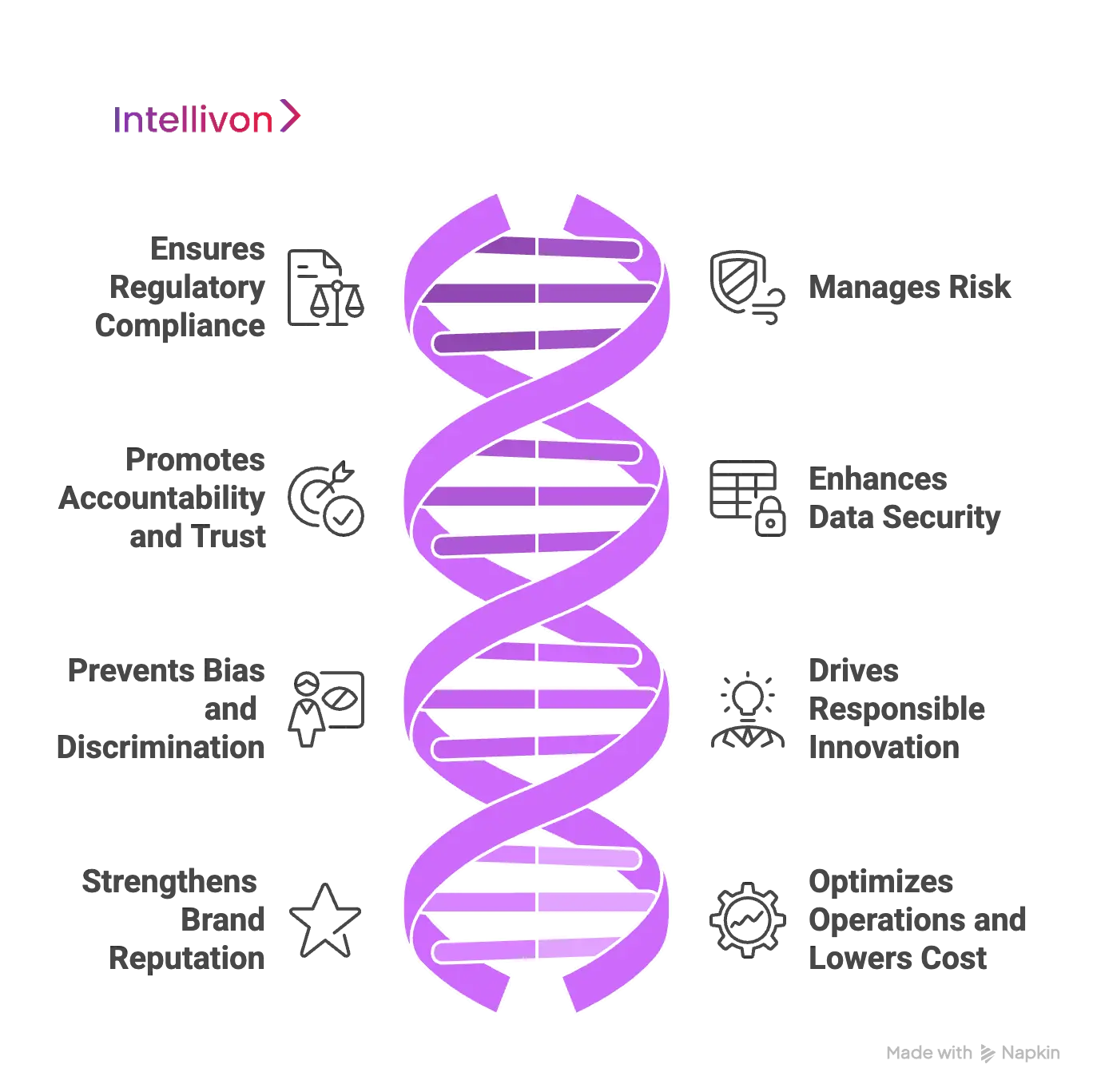
1. Ensures Regulatory Compliance
New AI laws are appearing around the world, such as the EU AI Act. These rules can be complex and strict. With a solid AI governance framework, enterprises can follow new regulations, avoid fines, and protect their reputation.
2. Manages Risk
AI systems can make mistakes or cause harm if not managed well. Without good oversight, they might introduce bias, privacy risks, or even security threats. AI governance sets clear rules to reduce these risks and protect everyone involved.
3. Promotes Accountability and Trust
AI decisions can seem mysterious or hard to explain. This can lead to doubt or worry among customers, staff, and partners. Good governance ensures that AI is transparent and its decisions can be traced. This helps organizations explain how AI works and builds trust with stakeholders.
4. Enhances Data Security
AI often relies on large amounts of sensitive data. Proper governance controls who can access this data and how it is used. As a result, businesses can protect their data and keep customer information safe.
5. Prevents Bias and Discrimination
AI can sometimes learn unfair patterns from data. Governance frameworks require enterprises to check for bias, review data sources, and run audits. This helps make sure AI treats everyone fairly.
6. Drives Responsible Innovation
Some people worry that rules slow down progress. However, AI governance actually helps enterprises move faster, with confidence. By setting clear standards, enterprises can adopt new AI tools safely, find new business opportunities, and avoid costly mistakes.
7. Strengthens Brand Reputation
Enterprises that are open and ethical about their AI use earn more trust. Good governance shows customers, regulators, and partners that the business is serious about responsible AI. This can make a company stand out from its competitors.
8. Optimizes Operations and Lowers Costs
Strong AI governance streamlines how companies manage AI projects. It makes audits and compliance easier, saving time and money. This means enterprises can scale their AI efforts and get more value from them in the long run.
Our Core Pillars of Enterprise AI Governance
Building a strong AI governance framework means starting with a solid foundation. When we build these frameworks for enterprises at Intellivon, we always focus on key pillars that form the base of our frameworks. These pillars make sure AI is used responsibly, earns trust, and supports growth.
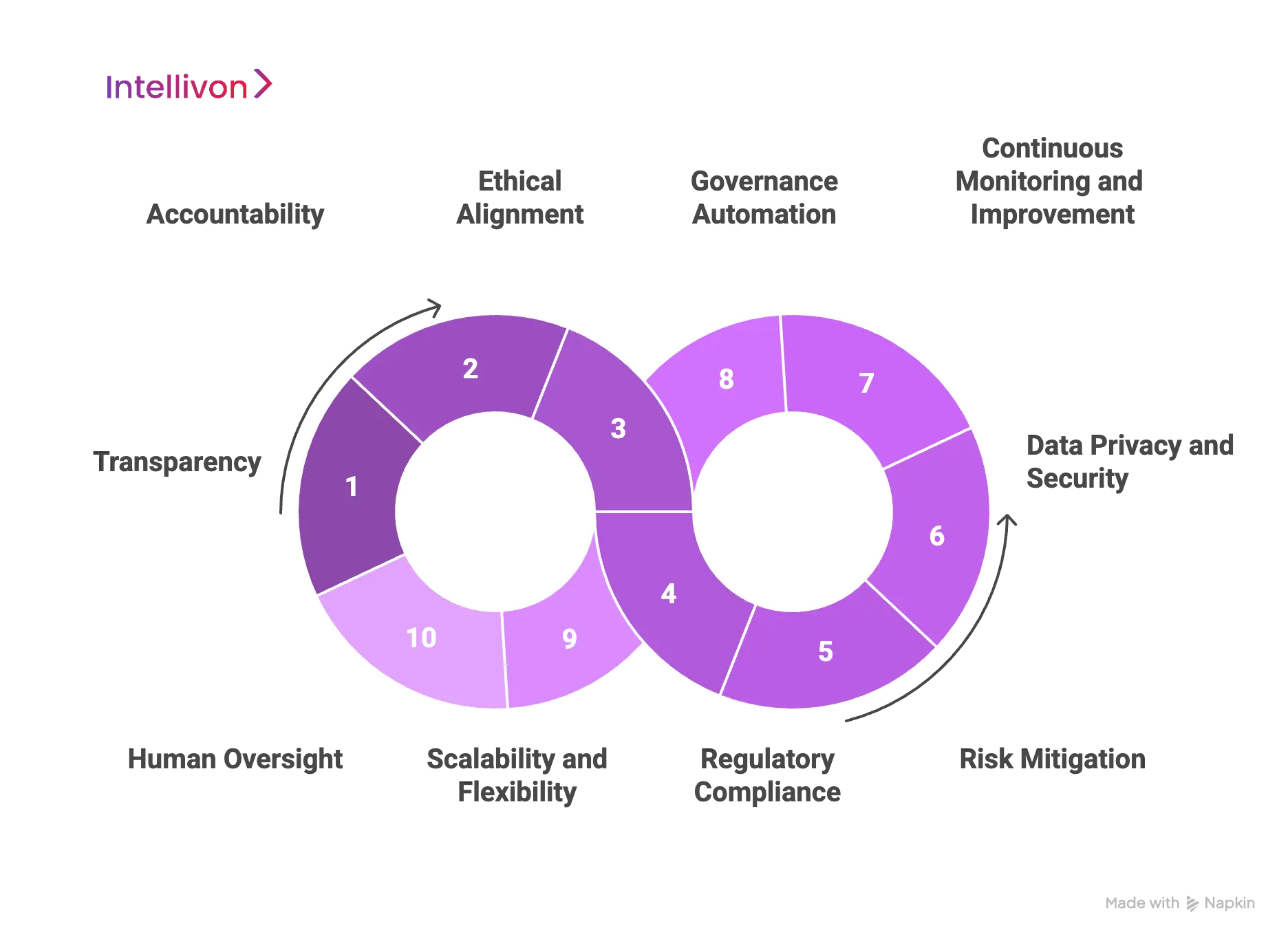
1. Transparency
Transparency is at the heart of effective AI governance. It means every decision made by an AI system should be clear and easy to explain. For example, if an enterprise uses AI to review job applications, the system’s choices need to be traceable. Stakeholders should be able to see why the AI picked one candidate over another.
This openness builds trust and makes it possible to address concerns quickly. In addition, regular audits help companies find and fix mistakes, keeping the entire process honest and reliable.
2. Accountability
Every AI project needs clear ownership. That’s why accountability is another essential pillar. We help enterprises define who is responsible for each part of the AI lifecycle. For instance, if an AI tool in a bank makes a decision about a loan, there should be someone who can answer questions and resolve issues.
Setting up roles, responsibilities, and escalation paths ensures that problems are addressed quickly and that no one can hide behind the technology.
3. Ethical Alignment
We ensure that AI enterprise systems treat everyone fairly. It’s not enough for AI to work; it must also reflect human values. For example, an AI that helps screen medical records should avoid discriminating against certain groups.
Regular checks for bias and discrimination are vital. Many organizations also set up ethics boards to review AI projects and keep them in line with company values. This ongoing commitment to fairness and inclusion shows customers and employees that the business cares about more than just the bottom line.
4. Regulatory Compliance
Staying on the right side of the law is non-negotiable for enterprises. Regulations like the GDPR, the EU AI Act, and HIPAA are now part of everyday business. A good AI governance framework makes compliance easier by building these rules into every step of the process. At Intellivon, our AI engineers have years of hands-on experience inserting these regulatory guidelines into every layer of the governance framework.
For example, a healthcare company handling patient data must follow HIPAA guidelines at all times. This protects both the business and its customers from legal trouble and costly fines. In addition, as laws change, companies need to update their frameworks to stay compliant and responsible.
5. Risk Mitigation
AI can unlock great value, but it also brings risks. Risk mitigation means being proactive rather than reactive. Putting necessary controls in place before the problem arises ensures you nip it in the bud.
For instance, regular vulnerability assessments can spot weaknesses in AI systems. Audit trails allow teams to look back at past decisions and understand what went wrong if something fails. Continuous drift detection helps catch issues when AI models start to perform differently over time. Together, these controls keep AI safe, stable, and trustworthy.
6. Data Privacy and Security
AI often handles sensitive and personal data. Data privacy and security are our top priority while building governance frameworks. This includes setting strict rules for how data is collected, used, and stored. Encryption protects data from unauthorized access, and access controls limit who can see and change information.
For example, a retail company using AI to analyze customer buying habits must keep purchase records secure. By applying privacy-preserving techniques, such as anonymizing personal details, businesses protect customer trust and follow best practices.
7. Continuous Monitoring and Improvement
After an AI system goes live, continuous monitoring is essential. We regularly check if enterprise AI models are accurate, fair, and working as intended. For instance, a fraud detection AI in a bank needs frequent updates to handle new threats.
Automated tools can alert teams when performance drops or when a model starts making biased decisions. This way, businesses can quickly fix problems and keep improving their systems over time.
8. Governance Automation
As companies scale up their use of AI, manual oversight becomes harder. That’s where governance automation comes in. Automation tools can track compliance, monitor model performance, and generate reports with little human effort.
For instance, an automated dashboard can alert teams if a machine learning model starts using out-of-date data. By automating routine tasks, organizations save time, reduce human error, and make it easier to govern complex AI systems at scale.
9. Scalability and Flexibility
No two enterprises are alike, and AI needs can change quickly. Therefore, we make governance frameworks scalable and flexible. They should work just as well for a single pilot project as for a global rollout.
For example, a manufacturing firm might start using AI on one production line, then expand across multiple plants. A flexible framework allows for easy adjustments as the company grows or as new rules appear. This adaptability is key to long-term success.
10. Human Oversight
Finally, no matter how advanced AI becomes, humans must remain in control. Human oversight means keeping people “in the loop” for important decisions. For instance, in healthcare, doctors must review AI-generated diagnoses before treating patients. This approach combines the speed of AI with human judgment and ethics. It helps prevent errors, protect individuals, and maintain public trust.
Keeping these core pillars in mind, we build AI governance frameworks that are robust, ethical, and adaptable. By focusing on transparency, accountability, and continuous improvement, companies can use AI to achieve their goals while keeping people and principles front and center.
Our Approach to Building Your Custom AI Governance Framework
At Intellivon, we know that every enterprise has a different story when it comes to AI. Your industry, regulations, technology, and company culture all play a part in shaping your journey. That’s why our AI governance framework is never just an off-the-shelf solution. Instead, we design each framework to fit your unique needs and goals, so you can innovate responsibly and stay competitive.

1. Discovery & Risk Assessment
1. Understanding Your AI Landscape
Our process begins with a deep dive into your current AI environment. We take a full inventory of all AI assets, from AI/ML models to automated tools used across your business. This step gives us a clear picture of where governance is most urgently needed.
For instance, if your finance team is using AI for credit risk scoring, we map out how these models work, where data comes from, and who is responsible. This visibility sets the stage for better control and oversight.
2. Assessing Regulatory and Ethical Risks
No enterprise operates in a vacuum. We study your industry’s regulatory requirements, whether it’s the EU AI Act, HIPAA for healthcare, GDPR for data privacy, or financial sector standards. Understanding these rules is key to creating a governance framework that stands up to scrutiny.
We also conduct ethical risk assessments. Our team screens for possible biases in data and algorithms, privacy concerns, and fairness issues. For example, we might uncover if an HR recruitment tool is favoring certain groups. By catching risks early, we help you avoid problems down the line.
3. Engaging Cross-Functional Teams
Good governance is a team effort. We organize workshops and interviews with your data science, legal, compliance, and business leaders. By including all voices from the start, our frameworks are practical and accepted across departments. This collaborative approach helps ensure that governance sticks and delivers real value.
2. Framework Design
1. Tailoring Governance to Your Needs
With a clear understanding of your environment, we start designing your custom AI governance framework. We focus on your main priorities, whether that’s strict compliance, improving trust, or reducing operational risk.
We determine which AI systems need the most oversight. For example, an AI used in medical diagnostics will have different governance needs than one used for marketing automation. We prioritize systems based on their impact, risk level, and importance to your business.
2. Establishing Clear Accountability
Responsibility is at the core of effective governance. We define roles like AI risk owners, model stewards, ethics officers, and executive sponsors. Each role comes with clear duties and escalation paths. So, if a model fails or a question comes up, everyone knows who to turn to.
3. Embedding Ethics and Compliance
We build ethical principles and legal requirements into every part of the framework. This includes setting rules for transparency, human oversight, and privacy by design. We standardize documentation, from model registries and audit logs to risk assessments. This makes it easy to trace decisions and report to regulators whenever needed.
4. Adapting to Change
Our governance frameworks are built to evolve. We include change management procedures so your policies stay up-to-date with new technology and regulations. This agility is key to staying ahead in a fast-moving AI world.
3. Technology Stack Setup
1. Integrating Powerful Governance Tools
Technology brings governance to life. We set up a stack of best-in-class tools for monitoring AI, detecting bias, managing access, and tracking model performance. For example, our model registry solution acts as a single source of truth. It tracks versions, metadata, and ownership across the full model lifecycle.
2. Centralizing AI Asset Management
Centralization makes oversight easier. All your AI models are registered in one place, making it simple to manage, audit, and update them. If a model is retired or changed, the system logs everything for future reference.
3. Automating Monitoring and Reporting
We automate tasks like drift detection, compliance reporting, and anomaly monitoring. For instance, if a model starts to produce unexpected results, automated alerts notify the right people. Our integration with your security and data platforms means that privacy is protected, and audit trails are easy to generate.
4. Organizational Enablement
1. Building Governance into Company Culture
Even the best framework fails without buy-in from your people. We help you set up cross-functional governance committees and an AI Governance Center of Excellence. This group leads responsible AI adoption throughout the company.
2. Training and Empowering Teams
We deliver targeted training to developers, compliance officers, legal teams, and business leaders. Developers learn how to code AI ethically. Legal and compliance teams master new frameworks and audit procedures. Leaders gain insights into how governance protects value and builds trust.
3. Sustaining Engagement and Alignment
Regular meetings ensure everyone is on the same page as new challenges arise. Communication strategies keep all employees informed about governance goals, successes, and their role in making AI safe and trustworthy.
5. Ongoing Support & Evolution
1. Continuous Improvement and Health Checks
AI governance is not “set it and forget it.” We provide regular audits, maturity checks, and system tuning to keep your framework strong. As your organization and regulations change, so does our support.
2. Keeping Pace with Regulatory Change
Our experts track laws and best practices worldwide. We deliver updates and guidance to keep your AI governance compliant and robust.
3. Incident Response and Managed Services
If a governance issue appears, we have formal processes for a quick, transparent response. For companies wanting extra peace of mind, our fully managed governance-as-a-service option covers everything, from 24/7 monitoring to audit support. You can focus on innovation, knowing your AI is safe and compliant.
At Intellivon, we blend deep AI, regulatory, and ethical knowledge with an enterprise-first approach. We know how large organizations work, with their complex systems and many stakeholders. Our frameworks are practical, scalable, and ready to grow with you.
Best Practices We Employ to Build AI Governance Frameworks for Your Enterprise
At Intellivon, we believe that AI governance is a continuous discipline woven deeply into the DNA of every enterprise we serve. Our approach is shaped by proven best practices that ensure your AI operations are responsible, ethical, and built to scale.
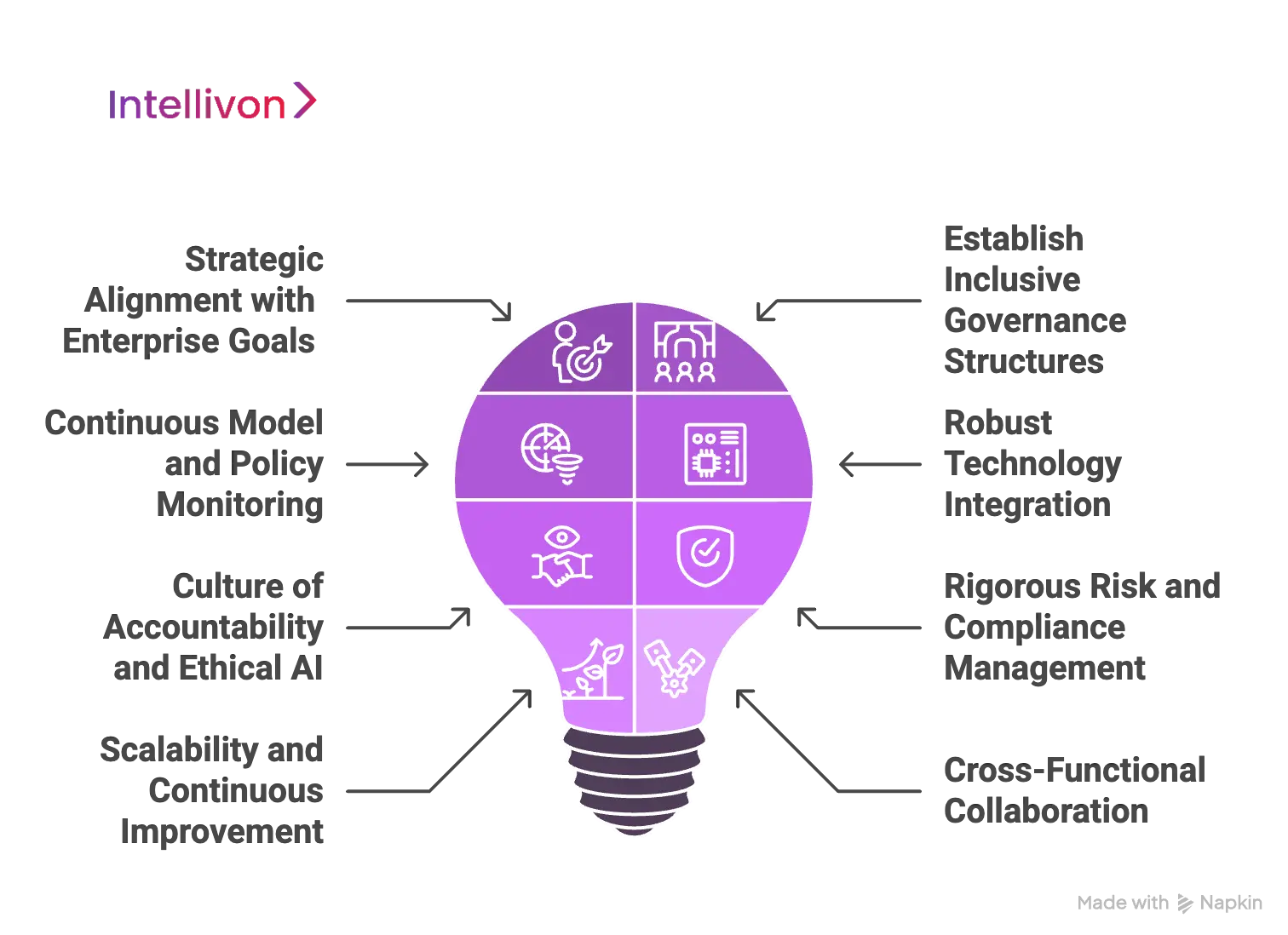
1. Strategic Alignment with Enterprise Goals
Every successful AI governance framework begins with strategy. We align our governance models with your organization’s long-term vision and core values. We work closely with your leadership and cross-functional teams in collaborative workshops.
This ensures your governance policies reflect not only legal requirements but also your business priorities, company culture, and ethical standards. The result? AI that is trusted by customers and regulators and delivers real business impact.
2. Establishing Inclusive Governance Structures
AI governance requires expertise from across your business. We help you form governance boards, ethics committees, and even regional governance councils for global enterprises. These bodies bring together IT, legal, compliance, ethics, data science, and business leadership.
By defining clear, transparent roles and responsibilities, we make sure everyone knows their part, and that decision-making is accountable and culturally sensitive at every stage of the AI lifecycle.
3. Continuous Model and Policy Monitoring
AI is always evolving, and so is governance. We implement continuous monitoring of all your AI models using advanced management tools. These tools track performance, fairness, and compliance automatically, flagging issues like bias or model drift before they can cause harm.
In addition, we schedule frequent policy reviews and build feedback loops with your end users and key stakeholders. This ensures that your governance adapts quickly to new technology and changing regulations.
4. Robust Technology Integration
Good governance relies on good technology. We integrate powerful AI model registries, explainability tools, risk detection systems, and audit automation into your existing IT landscape.
This creates a single, secure hub for managing all your AI assets and simplifies compliance reporting. Automation reduces manual workload and keeps oversight efficient, resilient, and up-to-date, even as your AI portfolio grows.
5. Culture of Accountability and Ethical AI
We know that true governance is about people as much as policy. That’s why we design and deliver tailored training for every level of your organization, from developers and compliance teams to senior executives.
Our programs build awareness, encourage ethical thinking, and create shared responsibility for AI’s impact. We set up an AI Governance Center of Excellence to keep best practices fresh, facilitate ongoing education, and support cultural change across your enterprise.
6. Rigorous Risk and Compliance Management
Managing risk and meeting regulations is non-negotiable. We help you set up comprehensive risk assessment frameworks and ethical risk screening procedures.
If an issue is found, clear incident response plans kick in immediately. Our governance solutions are built to comply with the toughest global standards, like GDPR, the EU AI Act, HIPAA, and more, so you are always audit-ready and protected from legal exposure.
7. Scalability and Continuous Improvement
As your enterprise and AI needs evolve, so must your governance. We build frameworks that are modular and scalable, able to grow and change as you do. Our continuous governance health checks and maturity assessments keep your framework relevant and effective.
For extra support, our governance-as-a-service offering delivers 24/7 monitoring and expert guidance, giving you peace of mind and freedom to innovate.
8. Cross-Functional Collaboration
We believe that the best governance is collaborative. Our approach brings together IT, compliance, legal, data science, and business units for regular committee meetings and performance reviews.
This cross-functional teamwork ensures practical, comprehensive governance and that issues are addressed before they become problems. Transparent communication keeps all stakeholders engaged and informed.
At Intellivon, we treat AI governance as an ongoing, enterprise-wide discipline. Our methodology not only protects you from risk and ensures compliance but also builds trust and unlocks AI’s full business potential. We partner with you every step of the way to make AI a driver of innovation, efficiency, and long-term competitive advantage.
Tools We Leverage to Build Enterprise-Ready Governance Frameworks
We select and integrate a best-in-class suite of tools, tailored to your enterprise’s unique AI ecosystem. Our approach ensures that your organization can govern AI responsibly, scalably, and with full regulatory confidence.
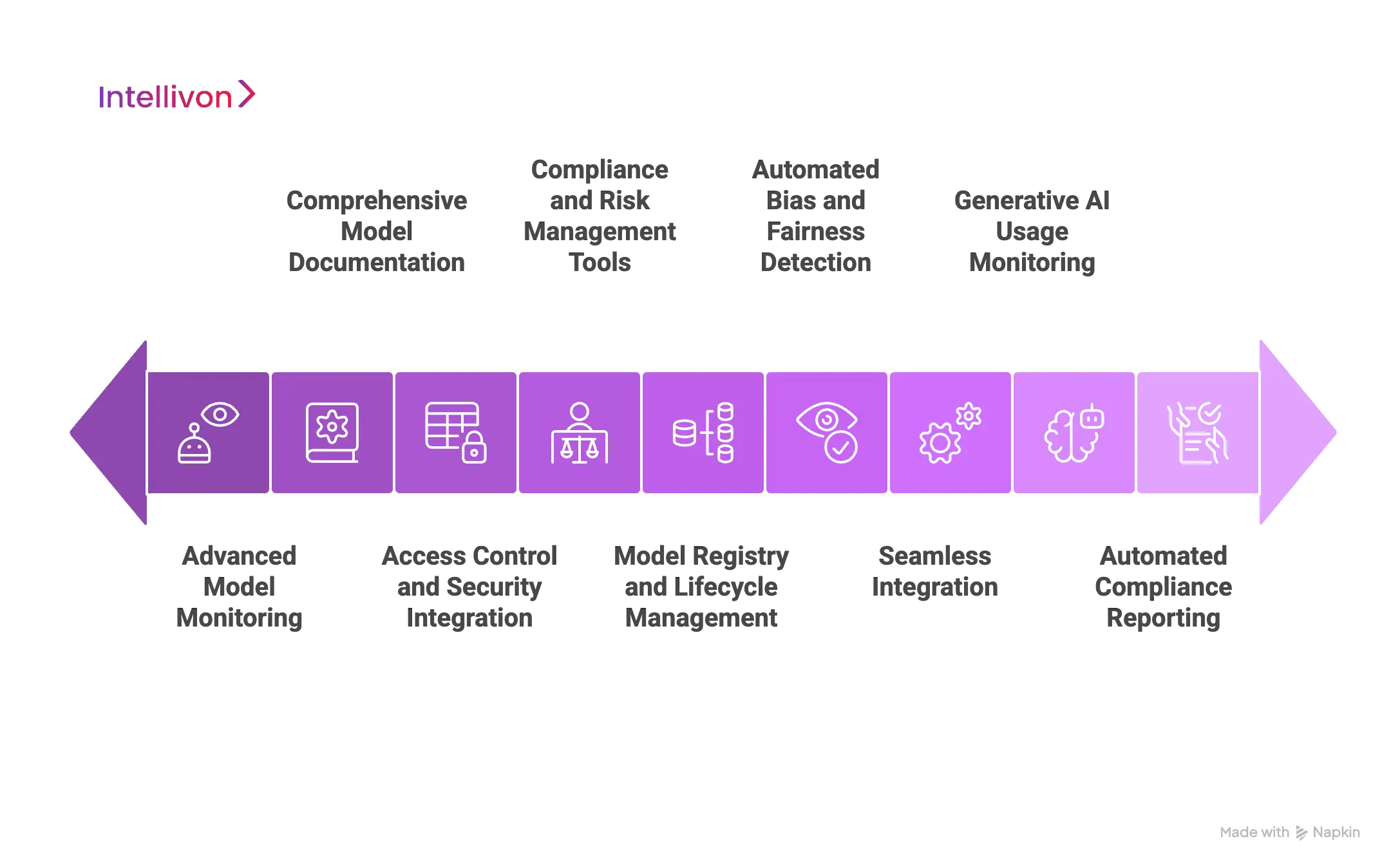
1. Advanced Model Monitoring
We deploy industry-leading platforms to keep your AI models performing at their best. These tools monitor for data drift, model drift, and unexpected anomalies, all in real time.
With proactive alerts, your team can quickly respond to any issues, helping you maintain reliable, accurate, and fair AI systems throughout the model lifecycle.
2. Comprehensive Model Documentation
Transparency is essential for both trust and compliance. To achieve this, we implement documentation standards using Model Cards and datasheets. These capture critical metadata, from training data sources to intended use, limitations, and performance scores.
We also layer on explainable AI (XAI) solutions, so stakeholders can clearly understand how and why your AI makes decisions. This not only satisfies regulatory needs but also supports stakeholder confidence across your business.
3. Access Control and Security Integration
Security is foundational to responsible AI. We enforce strict, role-based access controls that fit seamlessly with your existing workflows. By connecting with identity management solutions like Okta and Azure AD, we ensure that only the right people have access to sensitive AI assets. Detailed audit logs track every action and change, making it easy to investigate issues and meet audit requirements.
4. Compliance and Risk Management Tools
Meeting regulatory demands is non-negotiable. Our frameworks use powerful dashboards like IBM Watson OpenScale and the Azure Responsible AI dashboard. These automate key compliance tasks, such as bias detection, fairness checks, risk scoring, and generating compliance reports.
You’ll be ready for laws like the EU AI Act, GDPR, and HIPAA, with audit-ready evidence and efficient policy enforcement at every stage.
5. Model Registry and Lifecycle Management
Centralized control supports consistent, effective governance. We utilize model registries like ModelOp and MLflow to create a single source of truth for your AI assets. These tools provide comprehensive version control, metadata management, and full audit trails, spanning development, deployment, and retirement of models. This centralization makes tracking and compliance far easier.
6. Automated Bias and Fairness Detection
Ethical risks require constant attention. That’s why we deploy frameworks such as IBM AI Fairness 360 and Microsoft Fairlearn to continuously scan your models for bias and unfair outcomes. These tools make it possible to identify and correct ethical risks early, supporting both compliance and equitable AI.
7. Seamless Integration
AI governance should not be an island. We tightly connect our tools with your enterprise security stack, whether it’s SIEM systems, GRC tools like ServiceNow and Archer, or your DevSecOps pipelines. This integrated approach makes AI governance part of your broader risk and compliance program, rather than a siloed effort.
8. Generative AI Usage Monitoring
With the rapid growth of generative AI, we help you manage new risks. We integrate monitoring tools that track the use of LLMs and generative AI APIs, both on-premises and in the cloud. By detecting anomalies and managing access, we protect your business from emerging risks in this fast-evolving space.
9. Automated Compliance Reporting
Governance is only as strong as your reporting. We deploy solutions that automate the creation of audit-ready reports, both for internal reviews and regulatory submissions. This reduces manual effort, accelerates compliance workflows, and ensures your documentation is always up to date.
Our technology integration covers every aspect of enterprise AI governance. From model monitoring and explainability to bias detection and regulatory compliance, we give you the tools to deploy AI with confidence. By leveraging these best-in-class solutions, Intellivon empowers your organization to meet the highest standards of responsible AI at scale and across the globe.
Established AI Governance Frameworks and Models
As AI becomes more widespread, organizations need strong governance models to balance innovation with ethical and legal responsibilities. Several leading frameworks and models help enterprises manage AI systems safely and confidently. Here are some of the most recognized approaches:
1. The Hourglass Model
The Hourglass Model breaks down AI governance into three main phases: data preparation, model development, and outcome management. It encourages organizations to focus on high-quality data, apply strict controls during model creation, and monitor AI results after deployment. By overseeing the entire AI lifecycle, this model helps prevent problems before they start and supports ongoing responsible AI use.
2. Google’s AI Governance Approach
Google’s approach is built on public AI Principles, highlighting fairness, accountability, and social benefit. Google commits to not building AI for harmful or surveillance purposes and emphasizes that AI systems must always assist, not replace, human decision-making. Their principles also require that AI results are explainable, making the technology more transparent to users and regulators.
3. Singapore’s A.I. Governance (AIGA) Framework
Singapore’s AIGA Framework is a pioneer in national AI governance. It focuses on human-centric AI, explainability, and accountability. The framework encourages companies to follow voluntary guidelines, like ensuring responsible data use and transparent, understandable AI decisions. By making accountability a priority, AIGA builds trust in AI adoption.
4. OECD AI Principles
The OECD’s AI Principles are globally recognized and widely adopted. They cover inclusive growth, human-centered values, transparency, validity and security, and accountability. These principles set the foundation for ethical and sustainable AI use across both public and private sectors, encouraging organizations to reduce risks and maximize social benefit.
5. NIST AI Risk Management Framework
The NIST AI Risk Management Framework helps organizations identify, evaluate, and address risks related to AI. It stresses the importance of continuous risk assessments throughout the AI lifecycle and requires organizations to document any limitations or potential biases in their AI systems. This is especially valuable for industries where mistakes can have major consequences, such as healthcare or finance.
What Regulations Require an AI Governance Framework?
AI regulation is quickly evolving around the world. Some frameworks are legally binding, while others are considered best practices or voluntary guidance. It’s crucial for every organization to know which regulations apply to them.
Here is a summary of key regulations by region:
| Region | Regulation | Governance Required | Binding |
| European Union | EU AI Act | Yes | Yes |
| United States | SR-11-7 (Supervisory Guidance) | Indirectly (for AI in financial models) | No (Guidance) |
| Global | ISO/IEC 42001:2023 | Yes | Voluntary |
| Canada | AIDA (Artificial Intelligence and Data Act) | Yes | Pending Finalization |
| United Kingdom | Pro-innovation AI Regulation Framework | Indirect (Sector-Led) | No (Guidance) |
Staying aware of these frameworks and laws is essential for keeping your AI governance up-to-date, compliant, and future-ready. Intellivon helps enterprises interpret and implement these evolving standards as part of our ongoing partnership.
Conclusion
As AI continues to reshape the enterprise landscape, embracing strong governance will empower organizations to innovate boldly and ethically. By prioritizing transparency, accountability, and continuous improvement, businesses can not only meet regulatory demands but also earn lasting trust. The future belongs to those who govern AI responsibly, unlocking its full potential for positive impact and sustainable growth.
Ready to Build Your Governance Framework?
With over 11 years of enterprise AI expertise and 500+ successful deployments, Intellivon is your trusted partner in designing robust, compliant, and scalable AI governance frameworks, moving you far beyond generic, checkbox solutions. From real-time compliance monitoring to industry-specific risk management, we help enterprises shift from reactive governance to proactive, value-driven oversight.
What Makes Intellivon the Right Choice for AI Governance?
-
Industry-Aligned Governance Design: We tailor governance frameworks to your sector, regulatory landscape, and operational workflows, ensuring relevance and adoption.
-
End-to-End Security and Compliance: Our solutions integrate seamlessly with on-prem, cloud, and hybrid environments, featuring enterprise-grade encryption, role-based access controls, and detailed audit trails to meet even the strictest standards.
-
Regulation-Ready Flexibility: Our frameworks adapt to changing laws, supporting global standards like the EU AI Act, GDPR, and HIPAA, keeping you future-proof.
-
Automated Policy Enforcement: We deliver governance automation for continuous monitoring, bias detection, compliance reporting, and real-time issue escalation.
-
Business-Centric Governance: From AI ethics training to stakeholder communication plans, we align governance to your specific business needs, maximizing impact and trust.
Our governance experts will deliver:
-
A comprehensive audit of your AI landscape and governance maturity
-
Gap analysis and use case prioritization aligned with enterprise goals
-
Blueprint for a governance framework tailored to your infrastructure and regulatory requirements
-
Roadmap for continuous improvement, compliance automation, and stakeholder engagement
Book your free strategy call with an Intellivon governance expert today and start building the secure, transparent, and future-ready AI foundation your enterprise needs to lead with confidence.
FAQ’s
Q1: What is AI governance and why does my enterprise need it?
A1: AI governance is a set of policies, processes, and tools that ensure artificial intelligence is used responsibly, ethically, and in compliance with regulations. It’s essential for enterprises to manage risks, prevent bias, meet legal requirements, and build trust among customers and stakeholders.
Q2: How do AI governance frameworks help with regulatory compliance?
A2: AI governance frameworks incorporate the latest laws and standards, such as the EU AI Act, GDPR, and HIPAA, directly into your AI development and deployment processes. This helps enterprises stay compliant, avoid fines, and confidently demonstrate responsible AI practices to regulators and partners.
Q3: What are the biggest risks if we don’t implement robust AI governance?
A3: Without strong AI governance, enterprises risk regulatory penalties, security breaches, biased or discriminatory outcomes, reputational damage, and loss of customer trust. Proactive governance minimizes these threats and ensures AI delivers value safely and ethically.
Q4: How can enterprises ensure their AI governance frameworks remain effective as regulations change?
A4: Enterprises should design adaptable, scalable governance frameworks that can be updated as new laws and industry standards emerge. Regular audits, ongoing training, and continuous monitoring help organizations stay aligned with evolving requirements.

